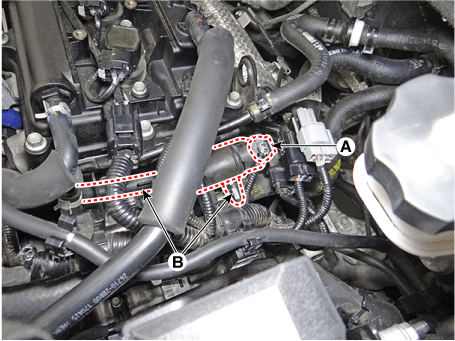Hyundai Venue: Engine Control System / Purge Control Solenoid Valve (PCSV). Repair procedures
| 1. |
Turn ignition switch OFF.
|
| 2. |
Disconnect PCSV connector.
|
| 3. |
Measure resistance between PCSV terminals 1 and 2.
|
| 4. |
Check that the resistance is within the specification.
|
Specification : 18.5 - 22.5Ω [23°C (68°F)]
|
|
| 1. |
Turn the ignition switch OFF and disconnect the battery negative (-)
terminal.
|
| 2. |
Disconnect the purge control solenoid valve connector (A).
|
| 3. |
Disconnect the vapor hoses (B) from the purge control solenoid valve.

|
| 4. |
Remove the purge control solenoid valve.
|
| • |
Install the component with the specified torques.
|
| • |
Note that internal damage may occur when the component is dropped.
In this case, use it after inspecting.
|
|
| • |
Be careful of foreign material not to flow into the valve.
|
|
| 1. |
Install in the reverse order of removal.
|
Description
The Continuously Variable Valve Timing (CVVT) system controls the amount of
valve overlap by varying the amount of oil flow into an assembly mounted on
the intake camshaft through ECM control of an oil control valve...
Other information:
The actual Jack label in the vehicle may differ from the illustration.
For more detailed specifications, refer to the label attached to the jack.
1. Model Name
2. Maximum allowable load
3. When using the jack, set your parking brake.
4. When using the jack, stop the engine...
Disassembly
•
Use fender covers to avoid damaging painted surfaces.
•
To avoid damaging the cylinder head, wait until the engine coolant
temperature drops below normal temperature (20°C [68°F]) before
removing it...
Categories

This gauge indicates the approximate amount of fuel remaining in the fuel tank.
Information
The fuel tank capacity is given in chapter 2.
The fuel gauge is supplemented by a low fuel warning light, which will
illuminate when the fuel tank is nearly empty.
On inclines or curves, the fuel gauge pointer may fluctuate or the low
fuel warning light may come on earlier than usual due to the movement of fuel
in the tank.
read more
 CVVT Oil Control Valve (OCV). Description and operation
CVVT Oil Control Valve (OCV). Description and operation




